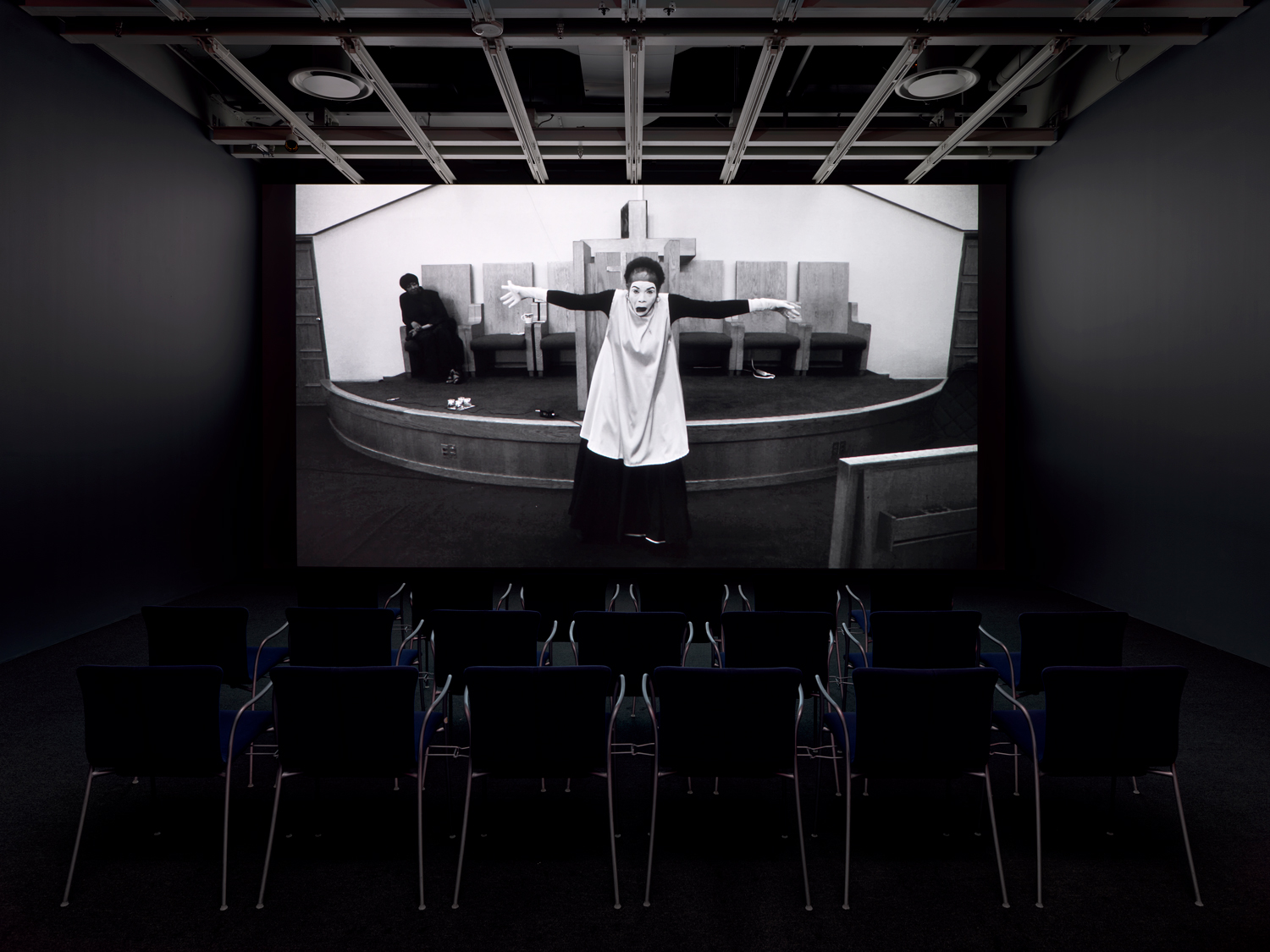[ad_1]
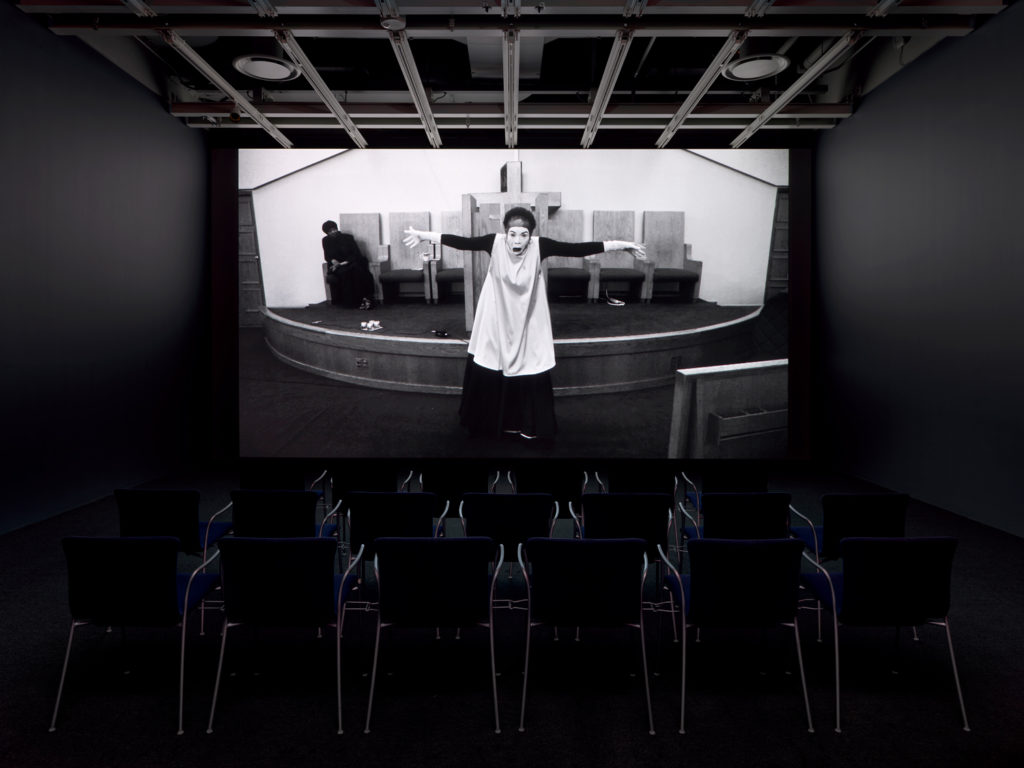
Steffani Jemison, Sensus Plenior, 2017, installation view, at the 2019 Whitney Biennial.
RON AMSTUTZ
A large screen shows an array of images on a lightbox, shuffled and without much context. From a set of speakers, a solemn voice of a woman draws me in as I hear other lookers shuffling to find seats. It’s a nice summer day, and I’m sitting low on a cushion with a friend, in a cold, dark, black space where a video plays. The voice, which belongs to the artist Ellie Ga, accompanies images she collected, weaving together a series of field notes regarding nautical excavations made by oceanographers, personal items that became debris by way of catastrophic tsunamis, and refugee migration routes along the Aegean Sea.
At first, the stories seemed to have no relation, but the forensic content became personal as we learned that one of the recovered adornments belonged to a worker who was friends with the artist’s sister. The work addresses separation, loss, and despair due to economic, climate, or political disaster. But just as equally, it’s about the interconnectedness of seemingly distant and desperate locales. And it underscores some of the thematic threads running through the Whitney Biennial: we are not all well, it has been difficult to find our footing, everything is in flux.
As has been noted many times since it opened, this year’s is among the most diverse Whitney Biennials in the exhibition’s history, and it includes work that address issues of equity (or lack thereof) and the precarity of certain bodies in an increasingly xenophobic world. The show forces us to consider the positioning of Americans who have historically occupied the periphery and how we might reimagine them at the center. And the artists in it are not always literal in terms of the visibility of their subject matter. Instead, in many instances, the Biennial opens up space for subjectivity to be rendered through multiplicity—and perhaps in ways not attainable to certain viewers. We are encouraged to ask what it means to consider subjectivity with regard to one’s own humanity as embodied through objects rather than being offered up in representations of that subjectivity instead.
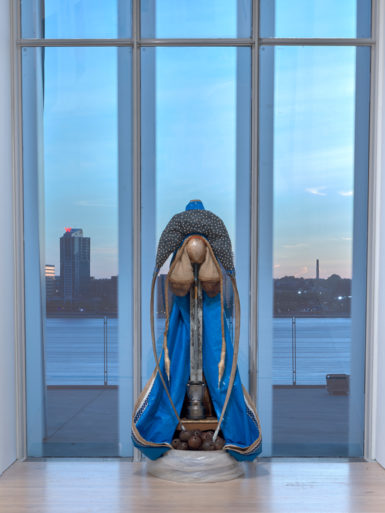
Daniel Lind-Ramos, Maria-Maria, 2019, installation view, at the 2019 Whitney Biennial.
RON AMSTUTZ
While thinking through my initial visits to the Biennial, I found myself returning to Toni Morrison’s essay collection What Moves at the Margin (2008)—particularly an essay titled “Rootedness: The Ancestor as Foundation” in which Morrison writes about the “presence of an ancestor” and how generative ancestral knowledge can be in the development of a creative practice. “Ancestors are not just parents,” she writes, “they are sort of timeless people whose relationships to the characters are benevolent, instructive, and protective and they provide a certain kind of wisdom.” Morrison gives us permission to be self-referential, to attend to the plurality of self.
As I’ve looked to the Whitney Biennial to think through our unsettled and increasingly fraught socio-political and environmental moment, it is clear that artists in the show are seeking out tools from their own beliefs—as well as personal and collective histories—to grapple with the present and find optimism for the future. One methodology centers on memory.
Daniel Lind-Ramos, who offers up a poetic assemblage of charged objects, has sourced material from his own community in Puerto Rico to make monumental constructions that reference the complicated and exploitative relationship between the U.S and its island territory in what he has called “an exercise of memory.” In Maria-Maria (2019), he constructed a Virgin Mary figure that resembles a yonic form with a blue tarp that was provided by FEMA to Puerto Ricans after the devastating hurricane in 2017 invoked by the work’s title. The tarp suggests the blue robe that often adorns Mary in Christian visual iconography; post-hurricane, it was intended as a structural adornment to take the place of destroyed roofs, but it is of course an inadequate material for protection. Here, Lind-Ramos unifies the world of materials and the world of faith, summoning destruction and protection at once.

Wangechi Mutu, Sentinel I, 2018, paper pulp, wood glue, concrete, wood, glass beads, stone, rose quartz, gourd, and jewelry.
COURTESY THE ARTIST
Wangechi Mutu incorporates a similar visual language in mannequin-like sculptures of wood and animal parts titled Sentinel I and Sentinel II. Sentinels are people who keep guard, who act as protectors, and the word happens to name another of Lind-Ramos’s works in the show: Centinelas (Sentinels), from 2013. In another work by Mutu, Poems by My Great Grandmother, a long string connects tree roots given to the artist by a neighbor with a dangling pencil that moves about in a circle, drawing a circle mark on an aluminum surface underneath. The kinetic function and the aural effect, aided by the work’s title, suggest a divine connection to the past, with Mutu gesturing toward notions of inherited knowledge, familial protection, and recovery from colonial rule.
Among the works screening in the Whitney’s theater, Steffani Jemison meditative video Sensus Plenor—Latin for “fuller meaning”—highlights how language and communication might become more effective through mime and muted gesture. For the first several minutes of the black-and-white film, we are met with the stealthy grace of Susan Webb, the leader of the Master Mime Ministry in Harlem. We watch Webb practice mime movement, in liturgical dress, as she paints her face white while talking to someone offscreen. While her voice is inaudible, her facial expressions reveal a breadth of language and lore.
In the final scene, Webb’s face is covered in white as she performs in front of a small pulpit with another Black woman, in what appears to be a velvet minister’s robe, sitting behind her and looking on. Jemison has altered the video in such a way that glitches Webb’s movement, and her body and the gospel music are blurred and slurred, as if in a conjuring. For someone familiar with Black Pentecostal culture, the movement cues are familiar, as the body becomes empowered and then submits. There is a consciousness that evokes Black American engagement with Pentecostalism evident here. Can an artwork be illegible and yet so clear at the same time? Jemison’s skill is in engaging such a point of contention.
In I Prayed to the Wrong God for You, Tiona Nekkia McClodden uses video and sculpture to materialize ancestral relations through a diasporic homegoing and the making of objects to be used in a ritual dedicated to Shango, an Orisha deity in the Afro-Cuban religion Santería/Lucumí whose origins can be traced to the Yoruba people of Nigeria. As a priestess of Ogun, McClodden works to repatriate and reclaim a spiritual practice that was compromised and forbidden during periods of colonialism, when religion—namely Christianity—was imposed on enslaved Africans and Black Southerners, and her work gives insight into the rigor required in sustaining such a practice. We follow McClodden through a series of labors and observances. With only an ax, she chops away at a tree in a forest to make wood, cuts slaps of wood, softens leather, visits family in Cuba, refines wooden and iron tools, and ends her repatriation in Ibadan, Nigeria, while a black motorcycle helmet bears witness to it all. To see it all, you have to walk around three televisions and peer overhead at three large panels where videos chronicling her multifarious practices are projected.
In 2019—exactly 400 years since the first enslaved Africans were brought to the British colony of Virginia—works like Jemison’s and McClodden’s make tangible the remnants and residue of the “peculiar institution” of slavery in the present. Where Jemison highlights the beautiful vernacular and coded linguistics that have come out of such acts of the imposed violences of religion, McClodden lets us into the divine practice of repatriating oneself to a place after being a victim of colonial cartographies and systems for generations.
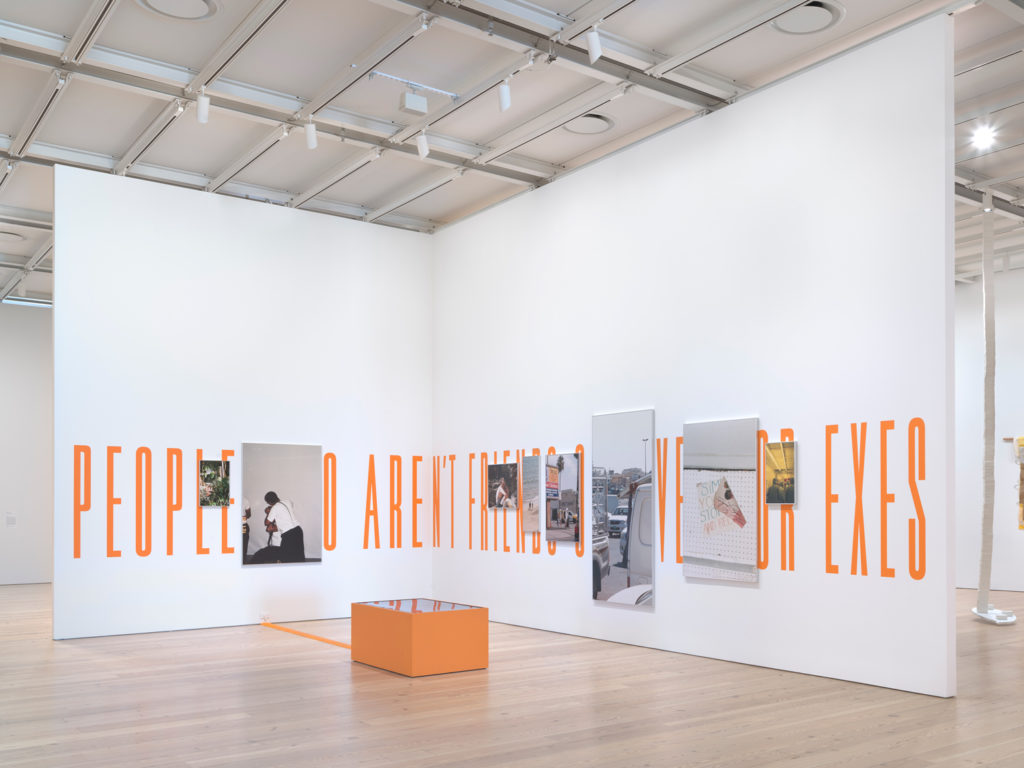
Installation view of works by Martine Syms, in the 2019 Whitney Biennial.
RON AMSTUTZ
In her 1993 essay “Coalition Politics,” activist and composer Bernice Johnson-Reagon describes the necessary work of coalition-building, a gesture in organizing that requires a willingness to work with a person or groups who may have conflicting ideals that are different from your own, in order to reach a greater solution for a movement. Johnson-Reagon suggest that sometimes, as means of survival, this involves working with someone “who may want to kill you.”
Martine Syms takes up this theory of distinction in her work Intro to Threat Modeling (2017), which is comprised of blurred photographs atop graphic orange text that reads “PEOPLE WHO AREN’T FRIENDS OR LOVERS OR EXES” on walls that isolate her installation from other works in the show. In the video, we hear Syms recite a letter to the curator Rujecko Hockley, explaining how Johnson-Reagon’s theory has helped to clarify some aspects of the art world for her. Johnson-Reagon was a Civil Rights–era musician and activist who worked in organizations like SNCC Freedom Singers alongside fellow activists like Fannie Lou Hamer. Johnson-Reagon had presented “Coalition Building” at the West Coast Women’s Music Festival in 1981 to make clear her understanding of politics and their deeply dependent dialogue with what we now might call emergent strategy. A space for coalition is a place where converging ideas and politics can develop and emerge. To arrive in such a space requires optimism, but it is inevitably difficult to organize a group of people who may have diverging political strategies of their own.
Syms’s tone in her work is full of anxiety, muffled rage, and dry humor, and there is a passionately instructive moment when she directs the audience not to take photos. (I watched as people wielded their phones to capture her manifesto only to pause awkwardly and reassess their plans upon hearing the order.) What Syms makes palpable is the codified precarity that may arise for a Black woman working in a space like the art world that answers to politics and strategies that are different from her own. While it can sometimes be a generative space for nuance and action, it is also a space that may produce trauma, and harm—echoing Johnson-Reagon’s reflection.
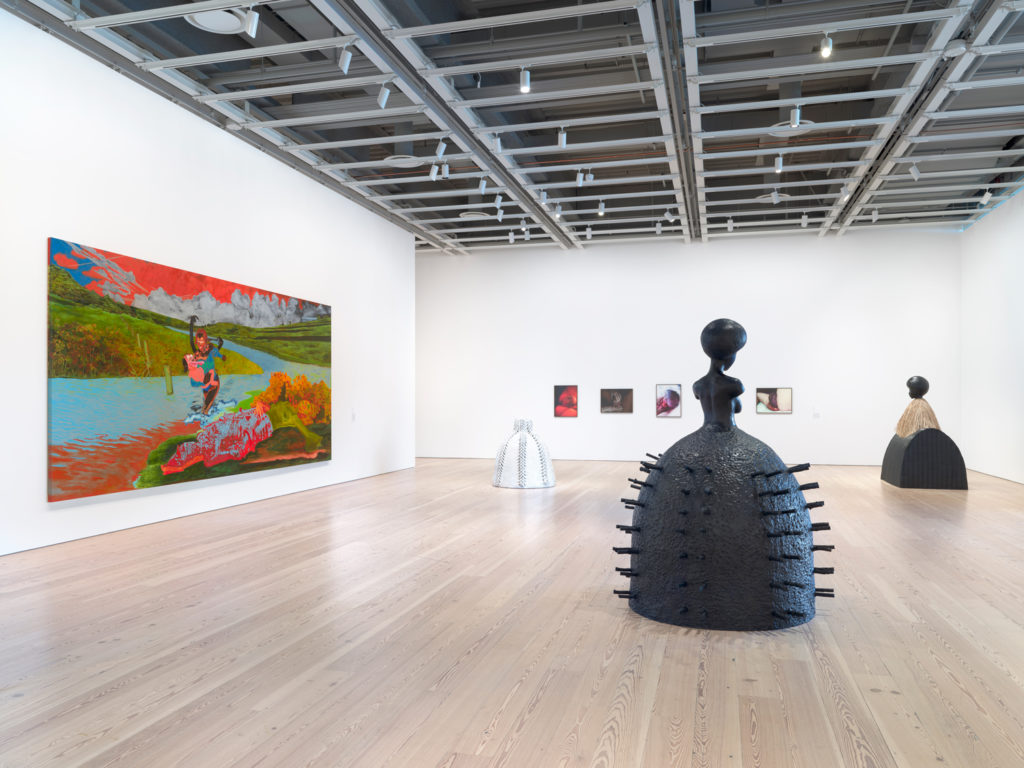
Installation view of the 2019 Whitney Biennial, showing Janiva Ellis’s Uh Oh, Look Who Got Wet, 2019, at left; sculptures by Simone Leigh, foreground; and photographs by Heji Shin, background.
RON AMSTUTZ
While sitting through Syms’s monologue, I couldn’t help but consider Johnson-Reagon’s theory in relation to the performative protests that surrounded this year’s Whitney Biennial. There has been a great amount of pressure for artists involved to coalesce within a paradoxical field of high capitalism and pseudo-organizing by self-proclaimed “artist-activists” and others funded by corrupt philanthropists appreciative of the idea of social justice but not keen on social justice as an actual practice.
But there is cause for criticism, including in the exhibition itself. Throughout my visits, I found myself most concerned with the placement of works. John Edmonds’s photographs that reimagine Black subjectivity and African sculpture after its disposition in modernity deserve fuller real estate in the museum, beyond the narrow hallway it fills. On the fifth floor, large female-figured sculptures by Simone Leigh that reference American architecture and traditional West African Adobe structures feel disjointed and crowded next to Heji Shin’s raw photos of babies in birth and a surreal painting by Janiva Ellis of two figures, one holding a baby and the other in stasis. And more space is not always the answer: Agustina Woodgate’s Detail of National Times (2016), which presents us with an entire room full of clocks to comment on the exploitive Western construct of time and the subjugation of the master over the enslaved in labor dynamics, only reproduces such exploits through the great amount of space the installation occupies.
Despite slight shortcomings, what is clearly evident is the comprehensive work and thoughtfulness that have been offered up by Biennial curators Jane Panetta and Rujecko Hockley, who acknowledge that the world right now is coarse. The Biennial reflects reality back to us in a way that is not hyperbolic or trite but rigorous, divine, and investigative. As Hockley remarks in her essay for the exhibition catalogue, in reference to the beautiful sermon of a character in Toni Morrison’s novel Beloved, “It is Morrison’s reminder that we ourselves are our prize, and the resultant almost obstinate optimism that it engenders, that keeps us going.” The 2019 Whitney Biennial is one of the more radical I’ve seen because it gives a platform to artists who are often self-referential and engaging with topics that cannot be familiar to all.
[ad_2]
Source link

